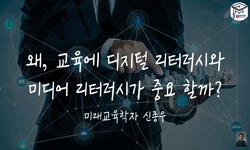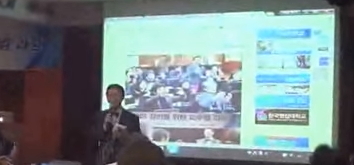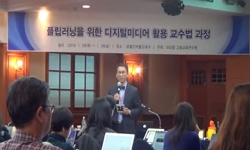시각문화교육은 포스트 모더니즘 이후, 미술교육의 새로운 패러다임이라고 볼 수 있다. 시각문화교육은 전통적인 미술교육에서 우리 주변을 둘러싸고 있는 시각 환경으로 그 관심의 폭을 ...
http://chineseinput.net/에서 pinyin(병음)방식으로 중국어를 변환할 수 있습니다.
변환된 중국어를 복사하여 사용하시면 됩니다.
- 中文 을 입력하시려면 zhongwen을 입력하시고 space를누르시면됩니다.
- 北京 을 입력하시려면 beijing을 입력하시고 space를 누르시면 됩니다.
https://www.riss.kr/link?id=A100027325
- 저자
- 발행기관
- 학술지명
- 권호사항
-
발행연도
2014
-
작성언어
Korean
- 주제어
-
등재정보
KCI등재
-
자료형태
학술저널
- 발행기관 URL
-
수록면
29-65(37쪽)
-
KCI 피인용횟수
7
- DOI식별코드
- 제공처
-
0
상세조회 -
0
다운로드
부가정보
국문 초록 (Abstract)
시각문화교육은 포스트 모더니즘 이후, 미술교육의 새로운 패러다임이라고 볼 수 있다. 시각문화교육은 전통적인 미술교육에서 우리 주변을 둘러싸고 있는 시각 환경으로 그 관심의 폭을 확대하였으며, 전통적인 순수예술에서 대중문화 및 영상예술 등으로 미술교육의 관심을 폭넓게 확장해 왔다. 시각문화교육은 이미지를 둘러싼 사회문화적 맥락에 주목하고, 비주얼 리터러시 능력을 강조하며 구성주의적인 학습을 강조한다는 면에서 문화예술교육의 이슈와 많은 부분을 공유하고 있으며, 실제로 문화예술교육의 주요한 이론적 배경이기도 하다.
이 글에서는 디지털 미디어 시대와 더불어 중요성을 더해가고 있는 애니메이션 교육의 방향성을 제시하기 위해, 시각문화교육의 이론적 배경 및 이슈를 살펴보고, 이와 관련하여 애니메이션 교육의 방향을 제시하였다. 시각문화교육은 1970년대 이후의 진보적인 문화적 배경 아래에서 탄생하였으며, 그 요지는 개인적이고 사회적인 삶의 개선을 위해 시각적 인공물과 그 행위의 의미를 파악하는 것이다. 그러나 시각문화교육은 시각문화 양상의 변화에 따라 지속적으로 발전 중이며, 현재에는 시각문화에서의 미적 체험교육이나, 디지털 스토리텔링을 통한 의미 구성등으로 그 관심을 확장하는 중이다. 디지털 미디어 시대의 시각환경에서 애니메이션은 시각문화의 중심에 자리잡고 있으며, 애니메이션은 하나의 예술장르, 혹은 테크놀러지를 넘어 시각문화 전반에 걸쳐 이미지가 구현되는 형식이기도 하다. 그간 시각적 의사소통 및 비판적 문화 읽기 등을 강조해온 시각문화교육 또한 미술교육의 체험에서 이해, 감상에 이르기까지 전 영역에 있어서 디지털-애니메이션 시각문화의 새로운 양상을 반영할 필요가 있을 것이다. 이 글에서는 애니메이션 교육 영역의 확장, 범교과적 접근, 사회재건주의적 교육철학, 애니메이션 리터러시 등을 강조하였다. 시각문화교육적 관점에 기초한 애니메이션 교육의 연구는 애니메이션 교육의 정립에 이론적 토대가 될 뿐 아니라 전통적인 비판적으로 텍스트 읽기 중심의 시각문화교육을 내용적으로 풍부하고 동시대적이고 미래적인 방향성에 도움을 줄 수 있을 것이다.
다국어 초록 (Multilingual Abstract)
Visual culture art education (VCAE) seems to be the new paradigm for art education after postmodernism. Getting beyond the traditional art education, VCAE has expanded its scope of interest to include the visual environment that surrounds our life, th...
Visual culture art education (VCAE) seems to be the new paradigm for art education after postmodernism. Getting beyond the traditional art education, VCAE has expanded its scope of interest to include the visual environment that surrounds our life, thus pushing the boundary of art education beyond the traditional fine arts to cover pop culture and visual art. VCAE shares the issues as well as a lot of elements of culture and art education and in fact serves as a major theoretic background for culture and art education, in that it pays attention to the sociocultural context of images and emphasizes visual literacy and constructionist learning.
In this paper, I have reviewed the theoretical background and related issues of VCAE with a view to presenting a direction for animation education, which is gaining in importance coming into the Age of Digital Media. VCAE was born in the progressive cultural atmosphere from the 1970s and thereafter, and its gist consists in figuring out visual artifacts and their action in order to improve individual and social life. Yet, VCAE continues with its development according to the changing aspects of visual culture, and currently, it is expanding its scope of interest to cover the esthetic, experiential education in visual culture and construction of meaning through digital story-telling. In the visual environment of the Digital Age, animation is establishing itself as the center of the visual culture, being a form that goes beyond an art genre or technology to realize images throughout the visual culture. Also, VCAE, which has so far emphasized visual communication and critical reading of culture, would need to reflect the new aspects of the visual culture in digital animation across the entire gamut from experiencing to understanding and appreciating art education. In this paper, I emphasize on Cross-Curricula, social reconstruction, the expansion of animation education, interests in animation as a digital media, and animation literacy. A study of animation education from the perspective of VCAE will not only provide a theoretical basis for establishing animation education, but also enrich the content of VCAE, traditionally focused on critical text reading, and promote its contemporary and futuristic orientation.
목차 (Table of Contents)
- 초록
- Ⅰ. 서론
- Ⅱ. 새로운 예술교육의 패러다임으로서의 시각문화교육
- Ⅲ. 디지털 시대의 시각문화교육으로서 애니메이션 교육의 방향
- Ⅳ. 결론
- 초록
- Ⅰ. 서론
- Ⅱ. 새로운 예술교육의 패러다임으로서의 시각문화교육
- Ⅲ. 디지털 시대의 시각문화교육으로서 애니메이션 교육의 방향
- Ⅳ. 결론
- 참고문헌
- ABSTARACT
참고문헌 (Reference)
1 김정선, "프리드먼의 시각문화교육론 연구" 한국초등미술교육학회 20 : 39-65, 2006
2 노르베르츠 볼츠, "콘트롤된 카오스" 문예출판사 2000
3 애플랜드, "인지중심 미술교육론" 교육과학사 1995
4 박정애, "의미 만들기의 예술" 시공아트 2009
5 박유신, "애니메이션 창작 교육에서 내러티브의 교육적 가치" 중앙대학교 첨단영상대학원 2012
6 안인기, "시각적 문해력 이후의 시각문화교육" 한국국제미술교육학회 15 (15): 55-74, 2014
7 폴 던컴, "시각문화에 관한, 시각문화 안에서, 시각문화를 통한 비평적 사고" 6 (6): 37-50, 2005
8 박유신, "시각문화교육에서 추상 애니메이션이 가지는 교육적 가능성" 한국미술교육학회 22 (22): 131-156, 2008
9 워커 채플린, "시각문화" 루비박스 2004
10 브라이슨, "시각과 시각성" 경성대학교 출판부 2012
1 김정선, "프리드먼의 시각문화교육론 연구" 한국초등미술교육학회 20 : 39-65, 2006
2 노르베르츠 볼츠, "콘트롤된 카오스" 문예출판사 2000
3 애플랜드, "인지중심 미술교육론" 교육과학사 1995
4 박정애, "의미 만들기의 예술" 시공아트 2009
5 박유신, "애니메이션 창작 교육에서 내러티브의 교육적 가치" 중앙대학교 첨단영상대학원 2012
6 안인기, "시각적 문해력 이후의 시각문화교육" 한국국제미술교육학회 15 (15): 55-74, 2014
7 폴 던컴, "시각문화에 관한, 시각문화 안에서, 시각문화를 통한 비평적 사고" 6 (6): 37-50, 2005
8 박유신, "시각문화교육에서 추상 애니메이션이 가지는 교육적 가능성" 한국미술교육학회 22 (22): 131-156, 2008
9 워커 채플린, "시각문화" 루비박스 2004
10 브라이슨, "시각과 시각성" 경성대학교 출판부 2012
11 이지연, "새로운 미술교육의 패러다임으로서의 시각문화교육의 가능성과 적용 연구" 한국국제미술교육학회 12 (12): 61-78, 2011
12 앤더슨 밀브란트, "삶을 위한 미술교육" 예경 73-, 2007
13 손지현, "브렌트 윌슨의 미술교육 사상과 시각문화 연구" 한국미술교육학회 20 (20): 1-18, 2006
14 아더 애프랜드, "미술교육의 역사" 예경 1996
15 데이비드 버킹엄, "미디어교육" inbook 161-,
16 김재웅, "문화예술교육 교육표준개발연구-만화·애니메이션" 한국문화예술교육진흥원 2011
17 레프 마노비치, "뉴미디어의 언어" 생각의 나무 2004
18 Carol Lauritzen, "내러티브 교육과정의 이론과 실제" 학이당 2007
19 마샬 맥루한, "구텐베르크 은하계" 커뮤니케이션 북스 2003
20 이상은, "각국의 교육과정 문서에 제시된 범교과적 교육과정(Cross-Curricula) 접근 방식 분석: 영국, 호주, 캐나다, 한국을 중심으로" 한국교육과정학회 26 (26): 59-79, 2008
21 Jagodzinski, J., "Visual art and education in an era of designer capitalism: Deconstructing the oral eye" Palgrave Macmillan 2010
22 VCAA, "Victorian essential learning standards: Overview" Victorian Curriculum and Assessment Authority 2005
23 QCA, "The national curriculum: Handbook for primary teachers in England: Key stage 1and 2" Qualifications and Curriculum Authority 1999
24 Lanier, V., "The Teaching of Art as Social Revolution" Phi Delta Kappan 1969
25 Ministry of Education, "The Ontario curriculum grades 11 and 12 : Interdisciplinary studies" Hellenic Pedagogical Institute 2002
26 Freedman, K., "Teaching visual culture: Curriculum, aesthetics and the social life of art" Teachers College Press 2003
27 Tavin, K. M., "Teaching (popular) visual culture: Deconstructing Disney in the elementary art classroom" 21-35, 2003
28 Efland, A. D., "Problems Confronting Visual Culture" 58 (58): 35-40, 2005
29 Silvers, Anita, "Pedagogy and Polemics: Are Art Educators Qualified to Teach Visual Culture?" 106 (106): 19-24, 2004
30 Education Queensland, "New basics project technical paper" Education Queensland 2000
31 Finnish National Board of Education, "National core curriculum for basic education 2004"
32 Smith, R. A., "Efland on the aesthetic and visual culture: A response" 284-288, 2005
33 QSCC, "Cross-curricular priorities: Lliteracy, numeracy, lifeskills, futures perspective"
34 Duffy, T. M., "Constructivism: New implications for instructional technology" A conversation 1-16, 1992
35 DUNCUM, Paul, "Clarifying visual culture art education" Art Education 6-11, 2001
36 Duncum, P., "An eye does not make an I: Expanding the sensorium" 53 (53): 182-, 2012
37 Hellenic Pedagogical Institute, "A cross-thematic curriculum framework for compulsory education"
38 애플랜드, "20 세기 미술교육에서의 진보의 비전" 2 : 65-92, 2001
39 김정선, "'미술교육” 에서 '시각문화교육' 으로-사회, 문화적 관점에서의 '시각문화교육'" 20 : 120-142, 2006
동일학술지(권/호) 다른 논문
-
한ㆍ미 장편 애니메이션에서 스토리와 관련된 유머의 차이에 대한 고찰
- 한국만화애니메이션학회
- 김윤정(Kim, Yun-Jung)
- 2014
- KCI등재
-
타바이모(TABAIMO) 애니메이션의 화면 공간과 움직임에 대한 연구
- 한국만화애니메이션학회
- 이진영(Lee, Jin-Young)
- 2014
- KCI등재
-
- 한국만화애니메이션학회
- 이혜원(Lee Hye-Won)
- 2014
- KCI등재
-
- 한국만화애니메이션학회
- 이종한(Lee, Jong Han)
- 2014
- KCI등재
분석정보
인용정보 인용지수 설명보기
학술지 이력
| 연월일 | 이력구분 | 이력상세 | 등재구분 |
|---|---|---|---|
| 2027 | 평가예정 | 재인증평가 신청대상 (재인증) | |
| 2021-01-01 | 평가 | 등재학술지 유지 (재인증) |  |
| 2018-01-01 | 평가 | 등재학술지 유지 (등재유지) |  |
| 2015-01-01 | 평가 | 등재학술지 유지 (등재유지) |  |
| 2011-01-01 | 평가 | 등재학술지 선정 (등재후보2차) |  |
| 2010-01-01 | 평가 | 등재후보 1차 PASS (등재후보1차) |  |
| 2009-01-01 | 평가 | 등재후보학술지 유지 (등재후보2차) |  |
| 2008-01-01 | 평가 | 등재후보 1차 PASS (등재후보1차) |  |
| 2006-07-21 | 학회명변경 | 한글명 : 사단법인한국만화애니메이션학회 -> 한국만화애니메이션학회 |  |
| 2006-01-01 | 평가 | 등재후보학술지 선정 (신규평가) |  |
학술지 인용정보
| 기준연도 | WOS-KCI 통합IF(2년) | KCIF(2년) | KCIF(3년) |
|---|---|---|---|
| 2016 | 0.64 | 0.64 | 0.7 |
| KCIF(4년) | KCIF(5년) | 중심성지수(3년) | 즉시성지수 |
| 0.67 | 0.66 | 0.988 | 0.08 |





 ScienceON
ScienceON DBpia
DBpia






